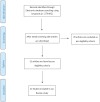Upper respiratory tract and otolaryngological manifestations of coronavirus disease 2019 (COVID-19): A systemic review
- PMID: 34094558
- PMCID: PMC8141987
- DOI: 10.1177/20503121211016965
Upper respiratory tract and otolaryngological manifestations of coronavirus disease 2019 (COVID-19): A systemic review
Abstract
To detect, analyze, and discuss the different ear nose throat manifestations, those were reported in coronavirus disease-positive patients in the published and reviewed literature. Coronavirus disease has been reported to present with several symptoms. Common symptoms include new onset of fever, cough, fatigue, and myalgia. Other symptoms like sputum production, dyspnea, rhinorrhea, anosmia, nasal stuffiness, headache, and sore throat are less frequently reported, but the clinical presentation is highly variable among individuals. We review the otolaryngologic manifestations of coronavirus disease reported in the published literature to assess its importance in the early diagnosis of coronavirus disease. We searched PubMed database, MEDLINE, Web of Science, LILACS, SciELO, and Cochrane Library to find out relevant articles, using the following keywords: COVID-19, clinical features, characteristics, symptoms, clinical, manifestations, throat, cough, rhinorrhea, COVID-19 anosmia, headache, nasal, coronavirus, and coronavirus otolaryngologic. Article selection was based on their relevance to the research question. Totally, 14 articles and 2971 patients were recruited for our study. A wide variety of upper and lower airway manifestations were reported. Fever (34%-96.5%), cough (17.9%-83%), myalgia or fatigue (10%-31%), expectoration (20%-32.7%), dyspnea (7.6%-7.5%), rhinorrhea (1%-6.8%), sore throat (4%-61%), nasal congestion (3%-4.8%), and headache (3%-16.2%) were the most common symptoms reported. Our findings confirm that coronavirus disease infection presents with a wide spectrum of clinical presentation. The ear nose throat manifestations for coronavirus disease are not uncommon, but more attention should also be paid to patients with otolaryngologic symptoms which can appear early, as this could encourage an earlier diagnosis and treatment, which limits spread of the disease.
Keywords: Anosmia; COVID-19; clinical features; coronavirus; cough; ear nose throat; headache; manifestation; otolaryngologic; rhinorrhea; symptoms; throat.
© The Author(s) 2021.
Conflict of interest statement
Declaration of conflicting interests: The author(s) declared no potential conflicts of interest with respect to the research, authorship, and/or publication of this article.
Figures
Similar articles
-
ENT manifestation in COVID-19 patients.Auris Nasus Larynx. 2020 Aug;47(4):559-564. doi: 10.1016/j.anl.2020.06.003. Epub 2020 Jun 15. Auris Nasus Larynx. 2020. PMID: 32586739 Free PMC article. Review.
-
Ear, Nose, and Throat Manifestations of COVID-19 in Children.Pediatr Ann. 2021 Jul;50(7):e277-e281. doi: 10.3928/19382359-20210613-01. Epub 2021 Jul 1. Pediatr Ann. 2021. PMID: 34264800 Review.
-
Ear, nose, and throat manifestations of COVID-19 and its vaccines.World J Clin Cases. 2022 Sep 6;10(25):8808-8815. doi: 10.12998/wjcc.v10.i25.8808. World J Clin Cases. 2022. PMID: 36157654 Free PMC article. Review.
-
Analysis of Ear, Nose and Throat Manifestations in COVID-19 Patients.Int Arch Otorhinolaryngol. 2021 Jul;25(3):e343-e348. doi: 10.1055/s-0041-1730456. Epub 2021 Jul 29. Int Arch Otorhinolaryngol. 2021. PMID: 34377166 Free PMC article.
-
COVID-19 in otolaryngologist practice: a review of current knowledge.Eur Arch Otorhinolaryngol. 2020 Jul;277(7):1885-1897. doi: 10.1007/s00405-020-05968-y. Epub 2020 Apr 18. Eur Arch Otorhinolaryngol. 2020. PMID: 32306118 Free PMC article. Review.
Cited by
-
Epipharyngeal Abrasive Therapy (EAT) Has Potential as a Novel Method for Long COVID Treatment.Viruses. 2022 Apr 27;14(5):907. doi: 10.3390/v14050907. Viruses. 2022. PMID: 35632649 Free PMC article.
-
Exploring the Clinical Utility of Gustatory Dysfunction (GD) as a Triage Symptom Prior to Reverse Transcription Polymerase Chain Reaction (RT-PCR) in the Diagnosis of COVID-19: A Meta-Analysis and Systematic Review.Life (Basel). 2021 Nov 29;11(12):1315. doi: 10.3390/life11121315. Life (Basel). 2021. PMID: 34947846 Free PMC article. Review.
-
Applying fuzzy qualitative comparative analysis to identify typical symptoms of COVID-19 infection in a primary care unit, Rio de Janeiro, Brazil.Sci Rep. 2022 Dec 24;12(1):22319. doi: 10.1038/s41598-022-26283-y. Sci Rep. 2022. PMID: 36566326 Free PMC article.
-
ENT symptoms in acute COVID-19: a narrative review.Acta Otorhinolaryngol Ital. 2022 Apr;42(Suppl. 1):S14-S19. doi: 10.14639/0392-100X-suppl.1-42-2022-02. Acta Otorhinolaryngol Ital. 2022. PMID: 35763271 Free PMC article. Review.
-
Post COVID-19 and Long COVID Symptoms in Otorhinolaryngology-A Narrative Review.J Clin Med. 2025 Jan 14;14(2):506. doi: 10.3390/jcm14020506. J Clin Med. 2025. PMID: 39860512 Free PMC article. Review.
References
-
- Cascella M, Rajnik M, Cuomo A, et al.. Features, evaluation and treatment coronavirus (COVID-19). Statpearls 2020. [Internet]. http://www.ncbi.nlm.nih.gov/pubmed/32150360 - PubMed
-
- NHC. National Health Commission of the People’s Republic of China main, 2019. [Internet]. http://en.nhc.gov.cn/ (accessed 20 January 2020). - PMC - PubMed
Publication types
LinkOut - more resources
Full Text Sources






